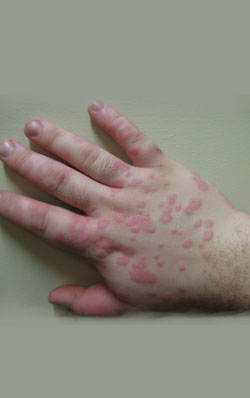
Infection involves the interaction between the host body and the infecting microorganism. The lodgement and multiplication of a parasite in or on the tissues of a host constitute infection. Certain pathogenic microorganisms are capable of producing infections or diseases in human beings. But it is not necessary that it results in disease. In fact, disease is a rare consequence of infection, which is a common natural event.
Infections are classified in many ways;
1. Initial infection with a parasite in a host is termed primary infection.
2. Subsequent infections by the same parasite in the host are re-infections.
3. When a new parasite sets up an infection in a host, whose resistance is lowered due to preexisting infectious disease, this is known as a secondary infection.
4. When generalized infections are produced at localized sites such as appendix or tonsils, it is focal infection.
5. When a patient suffering from a disease contracts another disease from any other external source, they are termed as cross infections.
6. Cross infections from hospitals are nosocomial infections.
7. Iatrogenic infections are those acquired from physicians during investigation or other such procedures.
8. When the source of the infection is from external sources, they are exogenous infections.
9. Endogenous infections have their source from the host’s own body.
10. Atypical infections are those where characteristic clinical manifestations of the particular disease are not present.
11. Following infections some parasites may remain hidden in the tissues proliferating and producing clinical disease when the host resistance is lowered. This is called as latent infection.
Sources of infection:
a) Humans are the most common source of human infections. The parasite may originate from a patient or a carrier. Carriers are people who harbor the pathogen without suffering from any ill effects caused by the pathogen. There are different types of carriers like healthy, convalescent, temporary, chronic carriers, etc.
b) Animals also act as carriers. They harbor the pathogen and transmit it to humans. They remain as reservoirs of the parasite causing human infections. Such diseases spread through animals are Zoonosis. Examples are plague from rats, rabies from dogs and certain fungal infections from dogs and cats.
c) Insects that suck blood may act as carriers of human infections. Such diseases are called arthropod- borne diseases. Mosquitoes, ticks, flies, fleas and lice are the most common insects that transmit diseases. They are termed as vectors. They may be either mechanical vectors transmitting disease unknowingly like house flies or may be biological, like mosquito, where the developmental stages may be taking place inside the human beings.
d) Soil provides safe place for several bacterial spores like that of Tetanus bacilli. Fungi like Histoplasma capsulatum, round worms, hook worms, etc. lives in soil.
e) Water when contaminated with pathogens like Vibrio cholerae, Salmonella, hepatitis virus, etc. acts as sources of infection.
f) Food which is contaminated with pathogens due to external contamination causes food poisoning. Examples are Staphylococcal infections, Clostridium botulinum infections, etc.
Types
Infectious diseases may be localized or generalized. Localized infections may be superficial or deep seated. Generalized infection involves the spread of the infecting agent from the site of entry through tissue spaces or channels, through the bloodstream.
Circulation of bacteria in blood is known as bacteremia. This is common even in healthy individuals and may occur during daily activities like brushing, chewing, etc., but these are engulfed by phagocytes. But when the bacteria circulate and multiply, it becomes septicemia and when pyogenic bacteria circulate, it is termed as pyemia.





